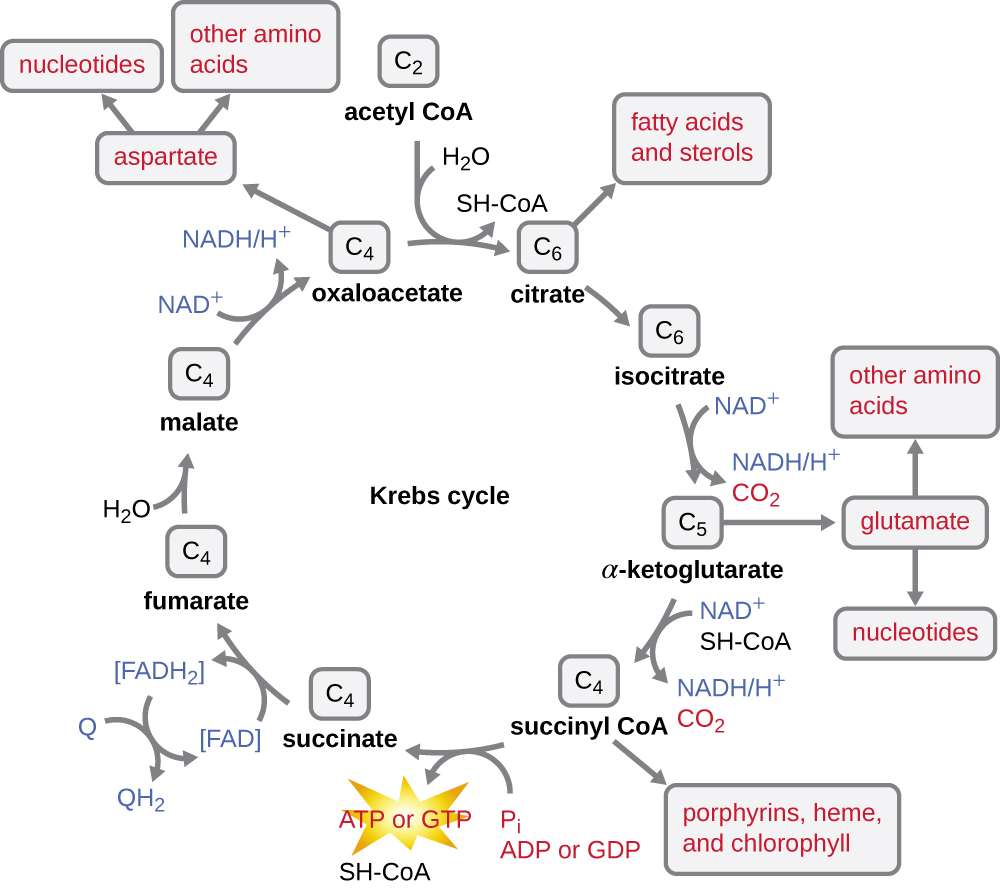| << Chapter < Page | Chapter >> Page > |
Glycolysis produces pyruvate, which can be further oxidized to capture more energy. For pyruvate to enter the next oxidative pathway, it must first be decarboxylated by the enzyme complex pyruvate dehydrogenase to a two-carbon acetyl group in the transition reaction , also called the bridge reaction (see Appendix C and [link] ). In the transition reaction, electrons are also transferred to NAD + to form NADH. To proceed to the next phase of this metabolic process, the comparatively tiny two-carbon acetyl must be attached to a very large carrier compound called coenzyme A (CoA) . The transition reaction occurs in the mitochondrial matrix of eukaryotes; in prokaryotes, it occurs in the cytoplasm because prokaryotes lack membrane-enclosed organelles.

The Krebs cycle transfers remaining electrons from the acetyl group produced during the transition reaction to electron carrier molecules, thus reducing them. The Krebs cycle also occurs in the cytoplasm of prokaryotes along with glycolysis and the transition reaction, but it takes place in the mitochondrial matrix of eukaryotic cells where the transition reaction also occurs. The Krebs cycle is named after its discoverer, British scientist Hans Adolf Krebs (1900–1981) and is also called the citric acid cycle , or the tricarboxylic acid cycle (TCA) because citric acid has three carboxyl groups in its structure. Unlike glycolysis, the Krebs cycle is a closed loop: The last part of the pathway regenerates the compound used in the first step ( [link] ). The eight steps of the cycle are a series of chemical reactions that capture the two-carbon acetyl group (the CoA carrier does not enter the Krebs cycle) from the transition reaction, which is added to a four-carbon intermediate in the Krebs cycle, producing the six-carbon intermediate citric acid (giving the alternate name for this cycle). As one turn of the cycle returns to the starting point of the four-carbon intermediate, the cycle produces two CO 2 molecules, one ATP molecule (or an equivalent, such as guanosine triphosphate [GTP]) produced by substrate-level phosphorylation, and three molecules of NADH and one of FADH 2 . (A discussion and detailed illustration of the full Krebs cycle appear in Appendix C .)
Although many organisms use the Krebs cycle as described as part of glucose metabolism, several of the intermediate compounds in the Krebs cycle can be used in synthesizing a wide variety of important cellular molecules, including amino acids, chlorophylls, fatty acids, and nucleotides; therefore, the cycle is both anabolic and catabolic ( [link] ).


Glycolysis requires oxygen or another inorganic final electron acceptor to proceed.
False
Per turn of the Krebs cycle, one acetyl is oxidized, forming ____ CO 2 , ____ ATP, ____ NADH, and ____ FADH 2 molecules.
2; 1; 3; 1
Most commonly, glycolysis occurs by the ________ pathway.
Embden-Meyerhof
What is substrate-level phosphorylation? When does it occur during the breakdown of glucose to CO 2 ?
Why is the Krebs cycle important in both catabolism and anabolism?

Notification Switch
Would you like to follow the 'Microbiology' conversation and receive update notifications?